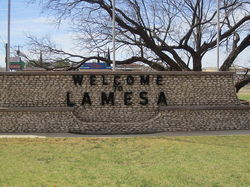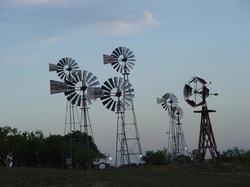History of Lamesa
LAMESA, TEXAS (Dawson County). Lamesa, the county seat of Dawson County, is on U.S. highways 180 and 87, State highways 137 and 349, Farm roads 179, 826, and 827, and the Santa Fe Railroad, and Sulphur Springs Draw, sixty miles south of Lubbock in the central part of the county. It was platted in July 1903 by Frank Connor, J. J. Lindsey, J. F. Barron, and several others. A. L. Wasson, a member of the first town committee, impressed by the tabletop flatness of the surrounding terrain, offered La Mesa and Lamesa as possible names. Although he preferred the Spanish version, the committee voted in favor of the other. A post office was granted in 1904 with Harrison B. Oliver as postmaster.
Lamesa won the county seat election by five votes over the rival town of Stemmons on March 20, 1905. A town meeting the next day invited the citizens and merchants of Stemmons to move to the new county seat, with an offer of free lots for businesses and help in moving houses. The offer was accepted and effected within several days. Early businesses in Lamesa included a hardware and furniture store, a hotel, a blacksmith shop, and several general stores. A school was first established in 1904. The town had a brass band by 1908. The Santa Fe Railroad secured the town's future when it arrived on August 4, 1910. Electrical service became available in 1916.
The first church building in Lamesa was the Methodist church, which was completed in 1907 with help from other local denominations. Baptist, Church of Christ, and Presbyterian churches followed by 1915. Lamesa prospered from farming and later through the development of the oil industry. The population was 1,188 in 1920 and rose to 6,038 in 1940 and to 10,706 in 1950. The peak years came in the 1960s, when the United States census reported 12,438 residents. Afterward the population fell slightly and stabilized around 11,559 in the 1970s and 1980s. In the mid-1980s Lamesa, the county's banking and marketing center, produced agricultural products, oil services, food processing, clothing and textiles, farming equipment, and cotton. Howard County Junior College, the Dawson County Museum, a hospital, a library, and several nursing homes are located in the city. In 1990 the population was 10,809. By 2000 the population was 9,952.
BIBLIOGRAPHY:
Leona Marguerite Gelin, Organization and Development of Dawson County to 1917 (M.A. thesis, Texas Technological College, 1937). Mathew Clay Lindsey, The Trail of Years in Dawson County (Fort Worth: Wallace, 1958?). (From the TSHA website)
Actor Barry Corbin was born in Lamesa. Preston Smith (Texas Governer 1969-1973) was from Lamesa.
Lamesa won the county seat election by five votes over the rival town of Stemmons on March 20, 1905. A town meeting the next day invited the citizens and merchants of Stemmons to move to the new county seat, with an offer of free lots for businesses and help in moving houses. The offer was accepted and effected within several days. Early businesses in Lamesa included a hardware and furniture store, a hotel, a blacksmith shop, and several general stores. A school was first established in 1904. The town had a brass band by 1908. The Santa Fe Railroad secured the town's future when it arrived on August 4, 1910. Electrical service became available in 1916.
The first church building in Lamesa was the Methodist church, which was completed in 1907 with help from other local denominations. Baptist, Church of Christ, and Presbyterian churches followed by 1915. Lamesa prospered from farming and later through the development of the oil industry. The population was 1,188 in 1920 and rose to 6,038 in 1940 and to 10,706 in 1950. The peak years came in the 1960s, when the United States census reported 12,438 residents. Afterward the population fell slightly and stabilized around 11,559 in the 1970s and 1980s. In the mid-1980s Lamesa, the county's banking and marketing center, produced agricultural products, oil services, food processing, clothing and textiles, farming equipment, and cotton. Howard County Junior College, the Dawson County Museum, a hospital, a library, and several nursing homes are located in the city. In 1990 the population was 10,809. By 2000 the population was 9,952.
BIBLIOGRAPHY:
Leona Marguerite Gelin, Organization and Development of Dawson County to 1917 (M.A. thesis, Texas Technological College, 1937). Mathew Clay Lindsey, The Trail of Years in Dawson County (Fort Worth: Wallace, 1958?). (From the TSHA website)
Actor Barry Corbin was born in Lamesa. Preston Smith (Texas Governer 1969-1973) was from Lamesa.
How Lamesa Became the Birthplace of the Chicken Fried Steak
The story states that in 1911 Jimmy Don Perkins, a short order cook, mistook two separate orders, on for chicken and one for fried steak, and from what Jimmy thought was a strange request the chicken fried steak was born. They say this is only a legend but in 2011 :a bill was signed naming Lamesa "The birthplace of the Chicken-Fried Steak" There is an annual Chicken-Fried Steak Festival in April which includes a chicken-fried steak cook-off, hot air ballons, a classic car show, and a 5K run.
The Wall
|
Photos from Around West Texas
Some scenery from around West Texas.
My Pets
|
My Kids |


